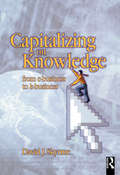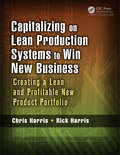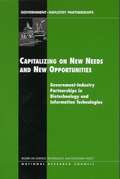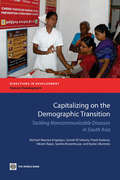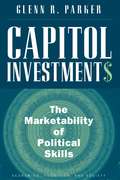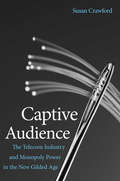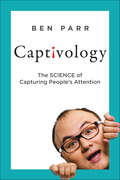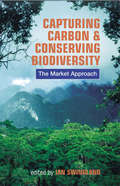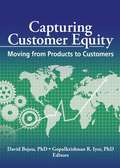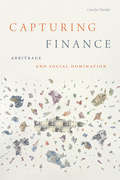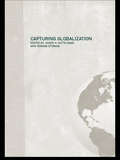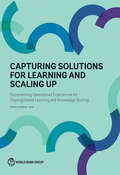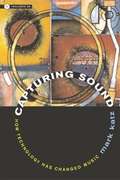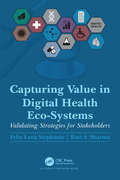- Table View
- List View
Capitalizing for the Future: HSBC in 2010
by Anette Mikes Dominique HamelFollowing the financial crisis of 2007/2008, HSBC CEO Michael Geoghegan saw a fundamental change in global opportunities and risks. With increasing regulation and fierce competition between banks, the Western hemisphere was going to be a tougher place to do business. Emerging markets, however, offered many opportunities. Geoghegan reasoned that in HSBC's case, a turn to emerging markets would be a return to its roots and to managing risks that it knew. But HSBC needed to understand what the implications of the new strategy-"moving to emerging markets"-were for its portfolio and overall risk profile. Especially, how should HSBC reallocate capital freeing up in the West across its diverse geographies and business lines?
Capitalizing on Change
by Stanley BuderAmericans love "this year's model," relying on the "new" to be always "improved." Enthusiasm for the new, says Stanley Buder, is essential to American business, where innovation and change stoke the engines of economic energy. To really understand the history of business in America, he argues, we must understand the intertwining dynamics of social and business values.In a history spanning over three hundred years, Buder examines the enveloping expansion of the market economy, the laggardly use of government to modify or control market forces, the rise of consumerism, the shifting role of small business, and much more. He concludes with the explosive development of business in the 1990s and its aftermath of crises and scandals. Along the way, he analyzes the ways American social values foster an entrepreneurial ethos and why the identification of change with progress provides a distinctive and provocative theme in American life. Buder studies American business as not only an engine of wealth accumulation but also an important generator and reflector of American values. Capitalizing on Change is the first full-length business history in recent years to make this relationship clear.
Capitalizing on Knowledge
by David SkyrmeMany organizations are embracing knowledge management as a source of strategic advantage. But already people are asking: "what comes next?" Likewise almost every large organization is heavily involved in e-commerce and turning their organizations into e-businesses. At the moment most e-commerce is focused on selling traditional products and services through the new medium of the Internet. However, the more an organization evolves into an e-business, the more they can exploit knowledge flows between themselves and their marketplace. This book draws together the two strands of knowledge and e-business into the emerging field that this book has called k-business. A k-business is one that turns an organization's knowledge assets into knowledge products and services and uses the Internet to market and deliver them online. Despite its newness, the Delphi Group have forecast that within 5 years person-to-person information e-commerce (a major aspect of k-business) will be a $5 billion business leveraging $50 billion in sales of other products and services. Capitalizing on Knowledge aims to give professionals and managers early insights into how to develop successful k-businesses. It takes a critical and balanced view of the building blocks of a k-business including knowledge productizing, e-commerce enablers and Internet marketing. It draws on lessons from successes and failures in the dot.com landscape and of the early pioneers of knowledge markets. The writing style engenders interest and readability supported by diagrams, screen images, check lists and frameworks. There are 'points to ponder' to stimulate thinking and decision-making. Five case studies and over 50 illustrative examples provide insights into the application of the book's concepts. No other book brings all the elements of a k-business together in one place to provide a thought provoking yet practical companion for those who want to capitalize on their knowledge.
Capitalizing on Lean Production Systems to Win New Business: Creating a Lean and Profitable New Product Portfolio
by Chris Harris Rick HarrisAlthough there are many organizations that have implemented Lean production systems and become more profitable as a result, there can be a gap between what those organizations currently do and how they should plan for and profit from new business. Capitalizing on Lean Production Systems to Win New Business: Creating a Lean and Profitable New Product Portfolio explains how to create a Lean product portfolio to fill that gap so you can become more profitable from that new business.Providing a fundamental understanding of the Lean enterprise production system, this book can help an organization take its current Lean knowledge and translate that knowledge into a step-by-step methodology to win and launch new business. Lean topics covered include:Value Stream MappingPlan for Every PartProcess Design and Standard WorkScheduling and Material FlowMachine ChangeoverQuality and Continuous ImprovementBy developing the New Product Acquisition and Launch Portfolio presented in this book, you can dramatically improve your ability to produce the products customers desire and deliver them on time. Focusing on the concepts that are critical to the longevity of your Lean enterprise system, this book will help you understand how to deliver a product that meets the quality and delivery standards of your customer. It will also help you understand how this new product fits into your Lean enterprise system.Detailing how to achieve a successful new product launch through upfront planning, this book provides you with the tools to enhance efficiencies throughout your supply chain.
Capitalizing on Nature
by Edward B. BarbierThe basic unit of nature - the ecosystem - is a special form of wealth, which we can think of as a stock of natural capital. However, perhaps because this capital is free, we have tended to view it as limitless, abundant and always available for our use, exploitation and conversion. Capitalizing on Nature shows how modeling ecosystems as natural capital can help us to analyze the economic behavior that has led to the overuse of so much ecological wealth. It explains how this concept of ecosystem as natural capital sheds light on a number of important issues, including landscape conversion, ecological restoration, ecosystem resilience and collapse, spatial benefits and payments for ecosystem services. The book concludes by focusing on major policy challenges that need to be overcome in order to avert the worsening problem of ecological scarcity and how we can fund novel financing mechanisms for global conservation.
Capitalizing on New Needs and New Opportunities: Government-Industry Partnerships in Biotechnology and Information Technologies
by National Research Council Technology Board On Science Economic PolicyThis report addresses a topic of recognized policy concern. To capture the benefits of substantial U.S. investments in biomedical R&D, parallel investments in a wide range of seemingly unrelated disciplines are also required. This report summarizes a major conference that reviewed our nation’s R&D support for biotechnology and information technologies. The volume includes newly commissioned research and makes recommendations and findings concerning the important relationship between information technologies and biotechnology. It emphasizes the fall off in R&D investments needed to sustain the growth of the U.S. economy and to capitalize on the growing investment in biomedicine. It also encourages greater support for inter-disciplinary training to support new areas such as bioinformatics and urges more emphasis on and support for multi-disciplinary research centers.
Capitalizing on the Demographic Transition
by Michael Maurice Engelgau Sameh El-Saharty Preeti Kudesia Vikram Rajan Sandra Rosenhouse Kyoko OkamotoIncreasing life expectancy in South Asia is resulting in a demographic transition that can, under the right circumstances, yield dividends through more favorable dependency ratios for a time. With aging, the disease burden shifts toward noncommunicable diseases (NCDs) which can threaten healthy aging. However, securing the gains expected from the demographic dividend-where developing countries' working and nondependent population increases and per capita income thus rises- is both achievable and affordable through efficiently tacking NCDs with prevention and control efforts. This book looks primarily at cardiovascular disease (CVD) and tobacco use since they account for a disproportionate amount of the NCD burden-the focus is strategic, rather than comprehensive. The goal of this book is to encourage countries to develop, adopt, and implement effective and timely country and, where appropriate, regional responses that reduce both population-level risk factors and the NCD burden. The work develops (i) an NCD burden and risk factor profile for all countries and the region as a whole; (ii) a rationale for public policy and action for NCDs; (iii) a framework to guide the formulation of public policies and strategies for NCDs; (iv) a country profile, including capacity and ongoing NCD activities, as well as policy options and actions for NCDs that will help stimulate policy dialogue within and among countries; and (v) a regional strategy for NCD prevention and control where regional collaboration offers added value. The achievements of this book are (i) developing a framework for policy options to identify key areas for strategic country- and regional-level policy and actions; (ii) bringing together demographic and aging trends, disease and risk factor burden data, alongside analyses of capacities and accomplishments to tackle NCDs; and (iii) using these inputs to develop policy options for country and regional strategies.
Capitanes
by Sam WalkerSam Walker examina en este fascinante ensayo la clave del éxito de los mejores equipos deportivos del mundo, y llega a sorprendentes conclusiones: la fuerza oculta detrás de los equipos más legendarios de la historia no es el entrenador, ni la estrella; no es el dinero ni la estrategia; es una cuestión totalmente distinta... Capitanes ha sido incluido en las listas:Top Business and Leadership Book de 2017 de Amazony 13 Best Business Books of 2017 de CNBC Hace diez años, Sam Walker decidió contestar la pregunta más controvertida sobre deporte: ¿cuáles son los equipos más exitosos de todos los tiempos? Mediante la estadística, identificó los 16 equipos con mayores triunfos a su espalda en todos los deportes, desde el fútbol, hasta el baloncesto, pasando por el rugby o el voleibol femenino. El siguiente paso era inevitable: ¿qué características en común tenían estos superequipos? Según avanzaba, Walker encontró un patrón: todos ellos tenían detrás un tipo muy especial de líder, un capitán, pero no el que uno esperaría. Eran anomalías heterodoxas, raros y poco sociables, no muy talentosos, malos comunicadores, rompían las reglas y, en vez de reclamar atención, preferían un segundo plano. Unos capitanes muy diferentes de lo que se espera de líderes inspiradores. A partir de equipos tan famosos como el F.C. Barcelona, la selección brasileña, los All Blacks o los New York Yankees, y otros menos conocidos como el equipo de hockey sobre hielo soviético o el de balonmano francés, Capitanes revela las siete cualidades fundamentales que un líder excepcional necesita. Basado en entrevistas exclusivas con atletas, entrenadores y dirigentes de decenas de países, Walker explica si los líderes nacen o se hacen, y por qué a veces se elige al capitán equivocado. No es solo un libro sobre deportes, es la clave de cómo se construyen grandes equipos y en qué se basa el liderazgo exitoso. Reseña:«Un buen libro sobre liderazgo que, muy inteligentemente, se hace pasar por un libro sobre deportes.»Andrew Ross Sorkin, The New York Times
Capitol Investments
by Glenn R. ParkerWhat would you do if, the very day you were hired, you knew you could be unemployed in as little as two years? You’d seek opportunities in your current job to develop a portfolio of skills and contacts in order to make yourself more attractive to future employers. Representatives and senators think about their jobs in Congress in precisely this way, according to Glenn R. Parker. While in office, members of Congress plan not merely for the next election but for the next stage of their careers. By networking, serving on committees, and championing particular legislation, they deliberately accumulate human capital—expertise, networks, and reputation—which later gives them advantages on the job market. Parker’s study of the postelective careers of more than 200 former members of Congress who left office during the last half century shows that, in most cases, the human capital these politicians amassed while in office increased their occupational mobility and earning power.
Capitol Park: Historic Heart of Detroit (Landmarks)
by Jack DempseyCapitol Park is the only city park in America where a state's first governor is buried. It's the birthplace of democracy in Michigan. Underground Railroad site. Streetcar and transit hub. Urban canyon. A block north of Detroit's iconic Coney Island restaurants. A symbol of the city's late twentieth-century decay, now a key part of its revitalization in a new millennium. Jack Dempsey, award-winning author of "Michigan and the Civil War" and president of the Michigan Historical Commission, uncovers tales of a uniquely inspirational public space that epitomizes the ups and downs of Detroit's three centuries.
Captivate: The Science of Succeeding with People
by Vanessa Van EdwardsDo you feel awkward at networking events? Do you wonder what your date really thinks of you? Do you wish you could decode people? You need to learn the science of people. As a human behavior hacker, Vanessa Van Edwards created a research lab to study the hidden forces that drive us. And she&’s cracked the code. In Captivate, she shares shortcuts, systems, and secrets for taking charge of your interactions at work, at home, and in any social situation. These aren&’t the people skills you learned in school. This is the first comprehensive, science backed, real life manual on how to captivate anyone—and a completely new approach to building connections. Just like knowing the formulas to use in a chemistry lab, or the right programming language to build an app, Captivate provides simple ways to solve people problems. You&’ll learn, for example… · How to work a room: Every party, networking event, and social situation has a predictable map. Discover the sweet spot for making the most connections. · How to read faces: It&’s easier than you think to speed-read facial expressions and use them to predict people&’s emotions. · How to talk to anyone: Every conversation can be memorable—once you learn how certain words generate the pleasure hormone dopamine in listeners. When you understand the laws of human behavior, your influence, impact, and income will increase significantly. What&’s more, you will improve your interpersonal intelligence, make a killer first impression, and build rapport quickly and authentically in any situation—negotiations, interviews, parties, and pitches. You&’ll never interact the same way again.
Captive Audience
by Susan P. CrawfordTen years ago, the United States stood at the forefront of the Internet revolution. With some of the fastest speeds and lowest prices in the world for high-speed Internet access, the nation was poised to be the global leader in the new knowledge-based economy. Today that global competitive advantage has all but vanished because of a series of government decisions and resulting monopolies that have allowed dozens of countries, including Japan and South Korea, to pass us in both speed and price of broadband. This steady slide backward not only deprives consumers of vital services needed in a competitive employment and business market--it also threatens the economic future of the nation.This important book by leading telecommunications policy expert Susan Crawford explores why Americans are now paying much more but getting much less when it comes to high-speed Internet access. Using the 2011 merger between Comcast and NBC Universal as a lens, Crawford examines how we have created the biggest monopoly since the breakup of Standard Oil a century ago. In the clearest terms, this book explores how telecommunications monopolies have affected the daily lives of consumers and America's global economic standing.
Captives: Alternative Finanzierung versicherungsfähiger Risiken
by Torsten Rohlfs Holger KrausDieses Buch gibt einen Überblick über Captives als Instrument der Finanzierung von versicherungsfähigen Risiken in Unternehmen. Hierzu sollen insbesondere eine allgemeine Einführung, die Gründe für den Einsatz dieses Instrumentes, Fragestellungen im Zusammenhang mit Gründung und Betrieb und die wesentlichen Ausprägungsformen und ihre jeweiligen Charakteristika beleuchtet werden. Ziel ist es, ein grundsätzliches, tieferes Verständnis zu vermitteln. Die einzelnen Kapitel sollen durch verschiedene Autoren geschrieben werden, die von beiden Herausgebern noch gesucht werden.
Captivology: The Science of Capturing People's Attention
by Ben ParrThe former editor of Mashable and cofounder of DominateFund examines the psychological phenomena that captivate our attention—and how we can leverage them to draw and retain attention for our ideas, work, companies, and more.Whether you’re an artist or a salesperson, a teacher or an engineer, a marketer or a parent—putting the spotlight on your ideas, insights, projects and products requires a deep understanding of the science of attention. In Captivology, award-winning journalist and entrepreneur Ben Parr explains how and why the mind pays attention to some events or people—and not others—and presents seven captivation triggers—techniques guaranteed to help you capture and retain the attention of friends, colleagues, customers, fans, and even strangers.Parr combines the latest research on attention with interviews with more than fifty scientists and visionaries—Facebook’s Sheryl Sandberg, film director Steven Soderbergh, LinkedIn CEO Jeff Weiner, magician Jon Armstrong, New York Times bestselling author Susan Cain, Nintendo’s Shigeru Miyamoto, founder of Reddit Alexis Ohanian, and more—who have successfully brought their ideas, projects, companies, and products to the forefront of cultural consciousness. The result is an insightful and practical book that will change how you assign jobs to your kids or staff, craft a multi-million dollar ad campaign, deliver your next presentation, attract users to your product, or convince the world to support your cause.
Capturing Carbon and Conserving Biodiversity: The Market Approach
by Ian R. SwinglandFor decades conservation has been based on the donor-driven principle. It hasn't worked. For centuries, environmental pollution or degradation has been addressed by the same attitude: the 'Polluter Pays' principle. That hasn't worked either. The cycle has to stop. But while everyone talks about using a market-driven approach, few know how to do it. Faced with the situation on the ground what do you do? What is happening? How can you engage a system so that it is self-sustaining and the people self-motivated? This study explores how the growing market in carbon can help to conserve carbon-based life forms. It discusses how reducing global warming and saving biodiversity can both be achieved with the right market conditions. The contributors include conservation biologists, ecologists, biologists, economists, lawyers, community and tribal specialists, financial specialists, market makers, environment specialists, climatologists, resource managers, atmospheric scientists, project developers and corporate fund managers.
Capturing Customer Equity: Moving from Products to Customers
by David Bejou Gopalkrishnan R. IyerOne of the most important new concepts in marketing is customer equity-here&’s the essential information you need to create and manage it!This book presents thought-provoking, cutting-edge writing on customer equity management. The editors and contributing authors are top international marketing researchers who share their expertise in this new area of marketing research and practice. Capturing Customer Equity: Moving from Products to Markets is designed to enable academics to chart out future research directions and to help marketers to apply recently developed frameworks to the creation and management of customer equity in domestic and international markets. Handy charts, tables, and figures make complex information easy to access and understand.Capturing Customer Equity: Moving from Products to Markets is divided into five chapters:Developing Relationship Equity in International MarketsThis chapter delves into the realm of relationship marketing to define the term relationship equity and presents strategies for enhancing relationship equity in international markets via personal relationships as well as consistent processes and outcomes. This chapter, written by the editors and their partner Arun Sharma, also looks at specific implications for relationship marketing theory and practice in international markets. Dimension and Implementation Drivers of Customer Equity Management (CEM)-Conceptual Framework, Qualitative Evidence, and Preliminary Results of a Quantitative StudyThis chapter explores theoretical considerations as well as qualitative and quantitative research applying confirmatory factor analysis. It identifies three important dimensions of Customer Equity Management (CEM)-analytical, strategic, and operational-as well as three types of CEM implementation drivers, which represent determinants of the three CEM dimensions. Authors Manfred Bruhn, Dominik Georgi, and Karsten Hadwich present the measures they&’ve developed for the CEM dimensions and drivers. These measures provide valuable help to practitioners and academics who need to understand how to manage and implement systematic customer equity management. A Network-Based Approach to Customer Equity ManagementThis chapter, by René Algesheimer and Florian von Wangenheim, moves beyond the dyadic relationship marketing concept to present a theoretical framework for extending current thinking on customer equity towards the network perspective. Based on the current literature in social work, this chapter examines the characteristics that are likely to be powerful predictors of a customer&’s network value. Practical implications are highlighted, and directions for further research are suggested.Strategies for Maximizing Customer Equity of Low Lifetime Value CustomersThe management of customer equity has become a major issue for many firms. This chapter examines strategies designed to assist firms in their relationships with customers who have low lifetime value. By examining the relevant literature as well as industry strategies, author Arun Sharma explores the reasons why "transactional" and "discount" customers have largely been ignored by marketing strategists, and proposes methods to enhance segment penetration and the performance of firms. Implications for managers are also highlighted. Customer Value-Based Entry Decision in International Markets: The Cnocept of International Added Customer EquityMarket entry decisions are some of a firm&’s most important long-term strategic choices. Still, the international marketing literature has not yet fully incorporated the idea of relationship marketing in general, and the customer value concept in particular, as a basis for market entry decisions. This chapter, by Heiner Evanschitzky and Florian von Wange
Capturing Finance: Arbitrage and Social Domination
by Carolyn HardinArbitrage—the trading practice that involves buying assets in one market at a cheap price and immediately selling them in another market for a profit—is fundamental to the practice of financial trading and economic understandings of how financial markets function. Because traders complete transactions quickly and use other people's money, arbitrage is considered to be riskless. Yet, despite the rhetoric of riskless trading, the arbitrage in mortgage-backed securities led to the 2008 financial crisis. In Capturing Finance Carolyn Hardin offers a new way of understanding arbitrage as a means for capturing value in financial capitalism. She shows how arbitrage relies on a system of abstract domination built around risk. The commonsense beliefs that taking on debt is necessary for affording everyday life and that investing is necessary to secure retirement income compel individuals to assume risk while financial institutions amass profits. Hardin insists that mitigating financial capitalism's worst consequences, such as perpetuating class and racial inequities, requires challenging the narratives that naturalize risk as a necessary element of financial capitalism as well as social life writ large.
Capturing Globalization (Routledge Advances in International Relations and Global Politics)
by James H MittelmanWhat are the moral codes and normative principles inscribed in globalization? How do diverse communities optimize their positions, and try to capture these processes? What are the foremost cultural and political attempts to govern the market? What are the social and ethical limits to a framework based on deregulation, privitization and liberalization? These related themes reveal how issues such as religion, private capital flows, poverty, the state and democracy, transnational class structures, disruptions in culture and new patterns in the use of language are part of the globalization process.Empirically, the research derives from data from fieldwork within and outside Southeast Asia, with a common reference point based on research in Malaysia. Following the trauma of the late 1990s - with environmental abuses in Southeast Asia, transnational turmoil in currency trading and the meltdown of stock markets - this book seeks to understand how, and to what extent, communities can reclaim political and social control over the dynamics of globalization. This highly original contribution to the globalization debate will be invaluable to researchers in a number of disciplines including political science, anthropology, history, economics, Asian Studies and sociology.
Capturing Solutions for Learning and Scaling Up: Documenting Operational Experiences for Organizational Learning and Knowledge Sharing
by Steffen Soulejman JanusIs your organization missing important lessons from its operational experiences? This step-by-step guide shows you how to systematically capture such knowledge and use it to inform decision making, support professional learning, and scale up successes. The captured lessons--knowledge assets, the central element needed for learning--are consistently formatted documents that use operational experience to answer a specific question or challenge. The guide describes how to create and use knowledge assets in five steps: (1) identify important lessons learned by participants, (2) capture those lessons with text or multimedia documents, (3) confirm their validity, (4) prepare them for dissemination, and (5) use them for sharing, replication, and scaling up. Included tools, templates, and checklists help you accomplish each step.
Capturing Sound: How Technology Has Changed Music
by Mark KatzMark Katz explores how recording technology has encouraged new ways of listening to music, led performers to change their practices, and allowed entirely new musical genres to come into existence.
Capturing Upside Risk: Finding and Managing Opportunities in Projects
by David HillsonWith more than three decades of experience as a thought-leader and expert practitioner, PMI Fellow Dr. David Hillson shares practical insight into how upside risks can be identified, assessed, and managed as opportunities. After reviewing the benefits of identifying opportunities, the book steps through the opportunity identification and management process in detail, describing proven tools and techniques as well as specific tips to make them work in practice. The book places opportunity management in the context of traditional risk management, providing a familiar pathway that leads project managers to discover new benefits and successes. David Hillson is one of the foremost authorities on risk management. With his latest book he presents a strong case for managing opportunities. As with all of David’s books, the style of writing is engaging and easy to understand. There are many nuggets of wisdom in this book, as well as a hands-on approach to leveraging opportunity management as a way of improving project performance. — Cyndi Snyder Dionisio, PMI Fellow, Coronado CA, USA. (Chair of the PMBOK® Guide, Sixth Edition) I enjoyed reading this book, which is precise, clear, logical, and persuasive. The clarity of thought and expression explains why David is such a sought-after speaker. This book is a must-read for project risk practitioners, as well as for project professionals who are serious about addressing all the risks on their project, including the good ones. — Dr Dale Cooper, Cammeray NSW, Australia. (Director, Broadleaf Capital International) At last, a clear and valuable book linking both sides of the coin in risk management: threats and opportunities. David Hillson truly engages the reader on how to deal with these two types of risk in projects, sharing his wisdom and extensive experience in creating value from risk management. Anyone who has to manage risk in real-world projects should read this book to enhance their opportunity management skills. — Professor Salim Al-Harthi, Muscat, Oman. (Director of Risk Management Office, Sultan Qaboos University) It is vital for value creation in business and in life that we consider uncertainties that would have upside impacts on our objectives (opportunities), as well as downside impacts (threats). Business gets confused between opportunities where there is a binary choice to take or not, and true uncertain opportunities that can be seized, or left to chance. David has persevered in helping us understand this and this important book is a must-read for all leaders who want to create value through the proactive management of risk. — Dr Ruth Murray-Webster, Wakefield, UK. (Partner, Beyond the Deal LLP and Editor, APM Body of Knowledge, 7th Edition) As project managers, we always seem to focus on threats, negative risks. David Hillson, one of the foremost thought-leaders on risk management, explains approaches to identify and manage opportunities, positive risks and how this will help achieve project success. As with his previous books, David provides a structured approach with examples, tools, and techniques. An excellent resource for all project managers in today’s world. — Peter Monkhouse, Toronto ON, Canada. (Past Chair PMI Board of Directors)
Capturing Value in Digital Health Eco-Systems: Validating Strategies for Stakeholders
by Felix Lena Stephanie Ravi S. SharmaThe United Nation's Sustainable Development Goals call for the establishment of Good Health and Well-being and target a universal digital healthcare ecosystem by 2030. However, existing technology infrastructure is ineffectual in achieving the envisioned target and requires massive reconfiguration to achieve its intended outcome. This book suggests a way forward with fair and efficient digital health networks that provide resource efficiencies and inclusive access to those who are currently under-served. Specifically, a fair and efficient digital health network that provides a common platform to its key stakeholders to facilitate sharing of information with a view to promote cooperation and maximise benefits. A promising platform for this critical application is ‘cloud technology’ with its offer of computing as a utility and resource sharing. This is an area that has attracted much scholarly attention as it is well-suited to foster such a network and bring together diverse players who would otherwise remain fragmented and be unable to reap the benefits that accrue from cooperation. The fundamental premise is that the notion of value in a digital-health ecosystem is brought about by the sharing and exchange of digital information. However, notwithstanding the potential of information and communication technology to transform the healthcare industry for the better, there are several barriers to its adoption, the most significant one being misaligned incentives for some stakeholders. This book suggests among other findings, that e-health in its true sense can become fair and efficient if and only if a regulatory body concerned assumes responsibility as the custodian of its citizens’ health information so that ‘collaboration for value’ will replace ‘competition for revenue’ as the new axiom in delivering the public good of healthcare through digital networks.
Capturing the Ecosystem of Demand: Placing Customer Advantage at the Center of Your Innovation Strategy
by Erich JoachimsthalerWhen an organization's understanding of the ecosystem of customer demand drives innovation and the business agenda, and when an organization's processes have been properly aligned, the chances are significantly high for sustainable, replicable, predictable growth. This chapter presents the demand-first innovation and growth model (DIG)-a systematic and repeatable process that helps companies embed the pursuit of customer advantage deep within the organization.
Capturing the Real Value in High-Tech Acquisitions
by Behnam Tabrizi Saikat ChaudhuriEager to stay ahead of fast-changing markets, more and more high-tech companies are going outside for competitive advantage. Last year in the United States alone, there were 5,000 high-tech acquisitions, but many of them yielded disappointing results. The reason, the authors contend, is that most managers have a shortsighted view of strategic acquisitions--they focus on the specific products or market share. That focus might make sense in some industries, where those assets can confer substantial advantages, but in high tech, full-fledged technological capabilities--tied to skilled people--are the key to long-term success. Instead of simply following the "buzz," successful acquirers systematically assess their own capability needs. They create product road maps to identify holes in their product line. While the business group determines if it can do the work in-house, the business development office scouts for opportunities to buy it. Once business development locates a candidate, it conducts an expanded due diligence, which goes beyond strategic, financial, and legal checks. Successful acquirers are focused on long-term capabilities, so they make sure that the target's products reflect a real expertise. They also look to see if key people would be comfortable in the new environment and if they have incentives to stay on board. The final stage of a successful acquisition focuses on retaining the new people--making sure their transition goes smoothly and their energies stay focused. Acquisitions can cause great uncertainty, and skilled people can always go elsewhere. In short, the authors argue, high-tech acquisitions need a new orientation around people, not products.
Capturing the Value of Intellectual Capital: Mastering the Legal Aspects of Business
by Constance E. BagleyThe ability to use intellectual property laws to capture the value of the firm's inventions, proprietary information, and other intangible assets is a key strategic advantage. This chapter shows managers how to use patents, copyrights, trade secrets, and trademarks both offensively and defensively.


